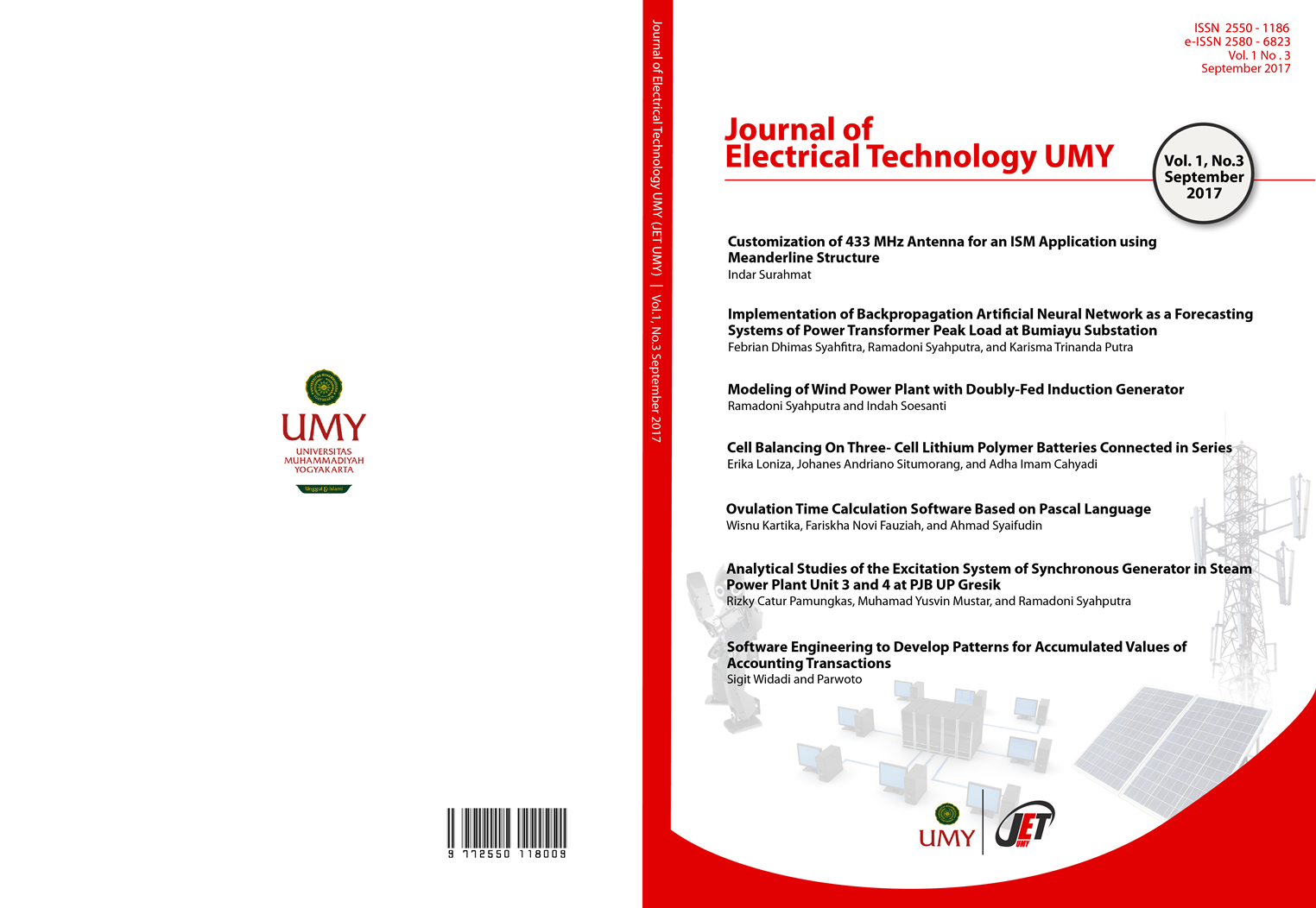Analytical Studies of the Excitation System of Synchronous Generator in Steam Power Plant Unit 3 and 4 at PJB UP Gresik
DOI:
https://doi.org/10.18196/jet.1320Keywords:
Sync Generator, Excitation Current, Excitation System, Over Excitation, Under ExcitationAbstract
Generator or alternator is a device that has a function to convert or transformmechanic energy to electricity. Electricity conversion need process with giving
strengthening with excitation current to coil magnetic field that placed on sync generator. Excitation current that flows on magnetic field coil will cause magnetic flux. Generator sync on PLTU unit 3 and 4 PJB UP Gresik use excitation system with excitation static type, this type of excitation it uses carbon brush as a media to conduct excitation current, this excitation system use the output of sync generator. In reality this excitation current which exist on PLTU unit 3 and 4 have to should always be taken care so the system can operate normally and commonly the fault that happened is under excitation and over excitation so it can be prevent. Step taken to avoid damaging the generator sync that caused by excitation current, steps that have to be taken are understanding the
characteristic of system excitation setting, anchor current, voltage generator, and loading. The value of loading is very affecting the value of excitation current that injected to generator, the purpose of this process of excitation current injection is to maintain the stability from sync generator voltage so that the condition is staying on its normal condition.
References
Bandri, Sepannur. 2013. Analisa Pengaruh Perubahan Beban Terhadap Karakteristik Generator Sinkron. Padang: Institut Teknologi Padang.
Basofi, Syamsul Amien. 2014. Studi Pengaruh Arus Eksitasi Pada Generator Sinkron Yang Bekerja Paralel Terhadap Perubahan Faktor
Daya. Medan: Universitas Sumatera Utara.
D. Jolevski. 2009. Excitation System of Synchronous Generator. Split: University of Split.
Jerkovic, dkk. 2010. Excitation System Models Of Synchronous Generator. Osijek: University of Osijek
Kurniawan, Aditia. 2015. Analisa Pengaruh Arus Eksitasi Generator Terhadap Pembebanan Pada PLTA Cirata Unit 2. Bandung: Politeknik Negeri Bandung.
Priyadi, Irnanda. 2014. Terhadap Efek Harmonisa Pada Hubungan Belitan Generator Sinkron Dengan Beban LHE. Bengkulu: Universitas Bengkulu.
Ridzki, Imron. 2013. Analisis Pengaruh Perubahan Eksitasi Terhadap Daya Reaktif Generator. Malang: Politeknik Negeri Malang.
Septian, Dwi. 2016. Studi Sistem Eksitasi Pada Generator Sinkron Di Pembangkit Listrik Tenaga Air (PLTA) Musi Bengkulu. Yogyakarta: Universitas Muhammadiyah Yogyakarta.
Sunarlik, Wahyu. 2013. Prinsip Kerja Generator Sinkron. Diunduh pada tanggal 15 November 2017. Pukul 20.40 WIB., dari http://updkediri.ac.id/wpcontent/uploads/2014/06/Prinsip-Kerja-GeneatorSinkron.pdf.
Syahputra, R. 2012. Distributed Generation: State of the Arts dalam Penyediaan Energi Listrik. Yogyakarta: LP3M UMY.
Syahputra, R. 2016. Transmisi dan Distribusi Tenaga Listrik. Yogyakarta: LP3M UMY.
Syahputra, R. 2015. Teknologi dan Aplikasi Elektromagnetik. Yogyakarta: LP3M UMY.
Terimanda, Nasrun Hariyanto, Syahrial. 2016. Studi Pengaturan Arus Eksitasi untuk Mengatur Tegangan Keluaran Generator di PT Indonesia
Power UBP Kamojang Unit 2. Bandung: Institut Teknologi Nasional Bandung.
Tiantoro, Feliks. 2009. Analisis Sistem Eksitasi Pada Generator Sinkron Tiga Fasa 67 MVA Di PT Indonesia Power PLTA Panglima Besar Soediran
Unit Bisnis Pembangkit Mica Banjarnegara. Purwokerto: Universitas Jendral Soedirman.
Syahputra, R., Robandi, I., Ashari, M. (2015). Reconfiguration of Distribution Network with DER Integration Using PSO Algorithm. TELKOMNIKA, 13(3). pp. 759-766.
Syahputra, R., Soesanti, I. (2016). Design of Automatic Electric Batik Stove for Batik Industry. Journal of Theoretical and Applied Information
Technology (JATIT), 87(1), pp. 167-175.
Syahputra, R., Robandi, I., Ashari, M. (2014). “Optimal Distribution Network Reconfiguration with Penetration of Distributed Energy Resources”, Proceeding of 2014 1st International Conference on Information Technology, Computer, and Electrical Engineering (ICITACEE) 2014, UNDIP Semarang, pp. 388 - 393.
Soedibyo, Ashari, M., Syahputra, R. (2014). “Power loss reduction strategy of distribution network with distributed generator integration”,
Proceeding of 2014 1st International Conference on Information Technology, Computer, and Electrical Engineering (ICITACEE) 2014, UNDIP Semarang, pp. 404 - 408.
Downloads
Published
How to Cite
Issue
Section
License
Copyright
The Authors submitting a manuscript do so on the understanding that if accepted for publication, copyright of the article shall be assigned to Journal of Electrical Technology UMY. Copyright encompasses rights to reproduce and deliver the article in all form and media, including reprints, photographs, microfilms, and any other similar reproductions, as well as translations.
Authors should sign Copyright Transfer Agreement when they have approved the final proofs sent by the journal prior the publication. JET UMY strives to ensure that no errors occur in the articles that have been published, both data errors and statements in the article.
JET UMY keep the rights to articles that have been published. Authors are permitted to disseminate published article by sharing the link of JET UMY website. Authors are allowed to use their works for any purposes deemed necessary without written permission from JET UMY with an acknowledgement of initial publication in this journal.
License
All articles published in JET UMY are licensed under a Creative Commons Attribution-ShareAlike 4.0 International (CC BY-SA) license. You are free to:
- Share — copy and redistribute the material in any medium or format
- Adapt — remix, transform, and build upon the material for any purpose, even commercially.
The licensor cannot revoke these freedoms as long as you follow the license terms. Under the following terms:
- Attribution — You must give appropriate credit, provide a link to the license, and indicate if changes were made. You may do so in any reasonable manner, but not in any way that suggests the licensor endorses you or your use.
- ShareAlike — If you remix, transform, or build upon the material, you must distribute your contributions under the same license as the original.
- No additional restrictions — You may not apply legal terms or technological measures that legally restrict others from doing anything the license permits.







